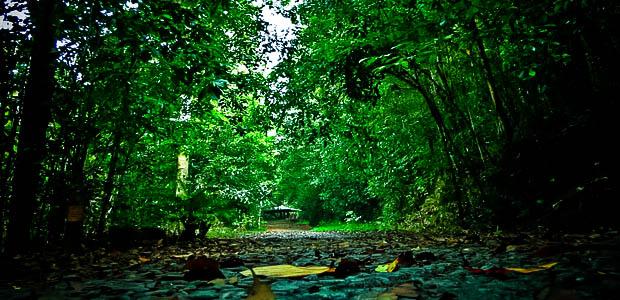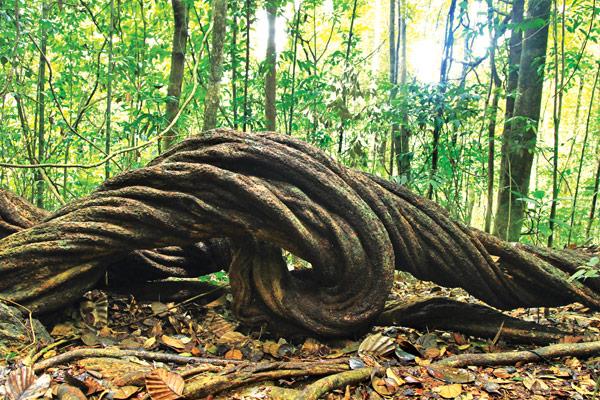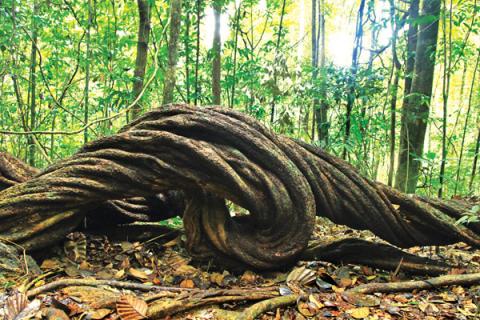Tropical wet lowland evergreen forest
The southwest region and the central hills of Sri Lanka have the most luxuriant forest cover. They have rain during the southwest monsoon and constitutes the lowland rain forests up to an elevation about 900 meters. At higher elevations they change to montane rain forests. Both these are very similar to those of India’s Western Ghats.
These forests are characterized by the dense canopy of tree species reaching 30-40 m in height with the emergent rising 45m above the canopy layer. Unlike the other forest types in Sri Lanka, rainforest are characterized by 5 main canopy layers as Emergent layer, Canopy, Mid canopy, Understory and Forest floor. Woody lianas form an intricate network inside the forest area. Trees bears some unique features as rainforest tree species show greater adaptation for long lasting rain falls, the leaves are even and have drip tips that allows excess water to fall off from the leaf surface. Trees are green throughout the year and since there aren’t any significant climatic variations within a year, trees continue to grow all round the year without shedding leaves at a specific time. Root systems of the plants are shallow because majority of the nutrients are present on the surface of the ground soil layer. Many roots become buttress stems to support these trees and prevent them from falling due to the shallow root system. These forests have a relatively sparse undergrowth but are rich in epiphytes and lianas. Epiphytes are those plants that hang on to a big tree, which is its host. It takes its food from the air. On the other hand, a parasite takes its food from the host plant itself. The interior of these forests are dark and dense. They have an understory made of small trees and shrubs and the ground layer consisting of herbs.
Sri Lanka’s lowland rainforests covering 2.1% of the land area harbour many endemic and threatened species. More than 60% of the 306 tree species that are endemic to Sri Lanka are found only in the lowland rainforests and some more are shared with montane and dry zone forests. Of the twelve endemic genera of flora of the island, eleven are confined to rainforests. The best known tropical rainforest in Sri Lanka is Sinharaja, internationally recognized as a world heritage site.

Kaneliya
Kaneliya, Dedugala, Nakiyadeniya complex known as the KDN forest, Bambarabotuwa, Morapitiya Runakanda, Gilimale and Eratne are some of the other reserves. The diverse vegetation of Sinharaja provides habitats to a wide array of fauna. Thiniya, (Shorea congestifolia) Duna (Shorea stipularis), Duna (Shorea zeylanica) are some of the emergents found in Sinharaja. Hora (Dipterocarpus zeylanicus), Honda Beraliya, (Shorea megistophylla)and Batu Naa (Mesua nagasarium)are some of the species that make the canopy. Thapassara bulath (Apama siliquosa) beru (Agrostistachys spp), Galkaranda (Humboldtia spp) are commonly found in the sub canopy. Herbs like Goniva (Acrotrema) Sandaraja (Anoectochilus setaceus), Lianas such as Calamus – Rattan palms, Entada pusaetha – Pus wel (Entada pusaetha), Coscinium – veniwel contribute to the variety of the forest.

Pus wel (Entada pusaetha)
The vertebrate animals of Sinharaja consists of about 50% of native inland animals of which 30% are endemic. Mammals like the Leopard (Panthera pardus), Purple faced Leaf Monkey (Semnopithecus vetulus)(endemic), Black naped Hare (Lepus nigricollus), Fishing Cat (Prionailurus Viverrinus) and Rusty Spotted Cat (Prionarilurus rubiginosus) are found together with numerous amphibian and reptile species. The vegetation dwelling tree frogs (Genus Philautus), who lay eggs in crevices and leaves and hatch out as tiny adults, are commonly found. All rainforests such as Sinharaja are famous for the colurful array of bird life. Sinharaja has four endemics the Blue Magpie (Cissa oronata), Green billed Coucal (Centrophus chlororhynchus), Sri Lanka Spurfowl (Galloperdix bicalcarta) and Sri Lanka Jungle Fowl (Gallus lafayetti). Mixed foraging bird flocks, that is a group of different bird species of birds moving together through the forest, is something that should not be missed. A mixed flock consists of an average of 40 individuals from more than 12 species.
When observing the climate of the rainforests, it does provide the ideal conditions for tropical evergreen forest tree species. An average temperature is approximately 23.6’C and annually receives more than 2500mm rainfall to the forest lands during the binaural monsoons. Most of the soil groups that can be found from rainforest is Red Yellow Podzolic Soils with clearly distinguishable horizons that vary with the soil depth. Little accumulation of Organic matter can be observed in the soil. Rainforest soil is a poor nutrient pool as many of the nutrients are attracted to the plant which has a greater demand for faster growth.

